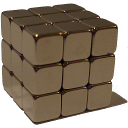
mumax3 tutorial
Following the release of mumax3.10, the DyNaMat group organized a mumax3 workshop
as part of the Online Spintronics Seminar Series
organized by the IEEE Magnetic Society.
The recordings and slides of this workshop can now be used as an in-depth tutorial.
Prerequisites
If you have a Windows or Linux PC with a CUDA-enabled graphics card of NVIDIA:
Try to download the latest version of mumax3 from mumax.github.io.
In session 2, we explain in detail how to run this mumax3 executable.
If you are already a mumax3 user, we recommend to use mumax3.10 or a later version.
If you do not have access to a machine which has a CUDA-enabled graphics card:
You can still follow the tutorial sessions.
In case you also want to try out the examples for yourselves, you can run mumax3 in Google Colab for free, if you have a Gmail account.
We prepared a Jupyter notebook to get mumax3 up and running in a Google Colab session:
.
Getting started
Below is a list of suggested reading material for those who want to familiarize themselves with computational micromagnetics:
- An introduction to micromagnetics
- The design and verification of MuMax3 (original mumax3 paper)
- Fast micromagnetic simulations on GPU—recent advances made with mumax3
- Tutorial: Simulating modern magnetic material systems in mumax3
Tutorial material
The workshop consisted of 4 sessions. For each session, the presentation slides, video recordings of the live presentations on VidGrid, and any relevant mumax3 input scripts are available below.
A list of questions which were asked live during the workshop can be found here.
Session 1
General introduction to micromagnetics in mumax3.
- Micromagnetics recap (LLG equation)
- Design of mumax3 (discretization and scripting interface)
Session 2
The mumax3 ecosystem, workflow and a first simulation.
- Installation on Windows/Linux
- Workflow: running simulation (standard problem 4) and processing output
- Extra's: run flags, benchmark, Google colab
- mumax3.ipynb (Google Colab example)
- bench.mx3 (GPU benchmark)
Session 3
Basic examples.
- Standard problem 3: phase diagram of ferromagnetic cube
- Skyrmion racetrack
- Slonczewski Spin Transfer Torque
- Intermezzo: solvers (Runge-Kutta, performance, adaptive time step)
- Thermal-gradient driven domain wall motion
- Standard problem 1: hysteresis + complex geometry
- Homework (solutions in Session 4)
Input scripts of examples
Session 4
Advanced features and more extensive examples.
- Homework assignment 1: ferromagnetic pyramid
- Homework assignment 2: VCMA skyrmion gate (standard method & batch simulation technique)
- Domain wall creep (material disorder & grains, moving window)
- Skyrmion racetrack revisited (SOT instead of STT, custom quantities)
- Skyrmion racetrack in synthetic antiferromagnet (interlayer exchange, spacer layer)
- Post-processing in Python
Input scripts of examples
Homework solutions
Post-processing output data with Jupyter notebook
If you can run mumax3 on your system, then you should be able to run this notebook locally on your machine.
It is also possible to run the notebook in a google colaboratory session
.

